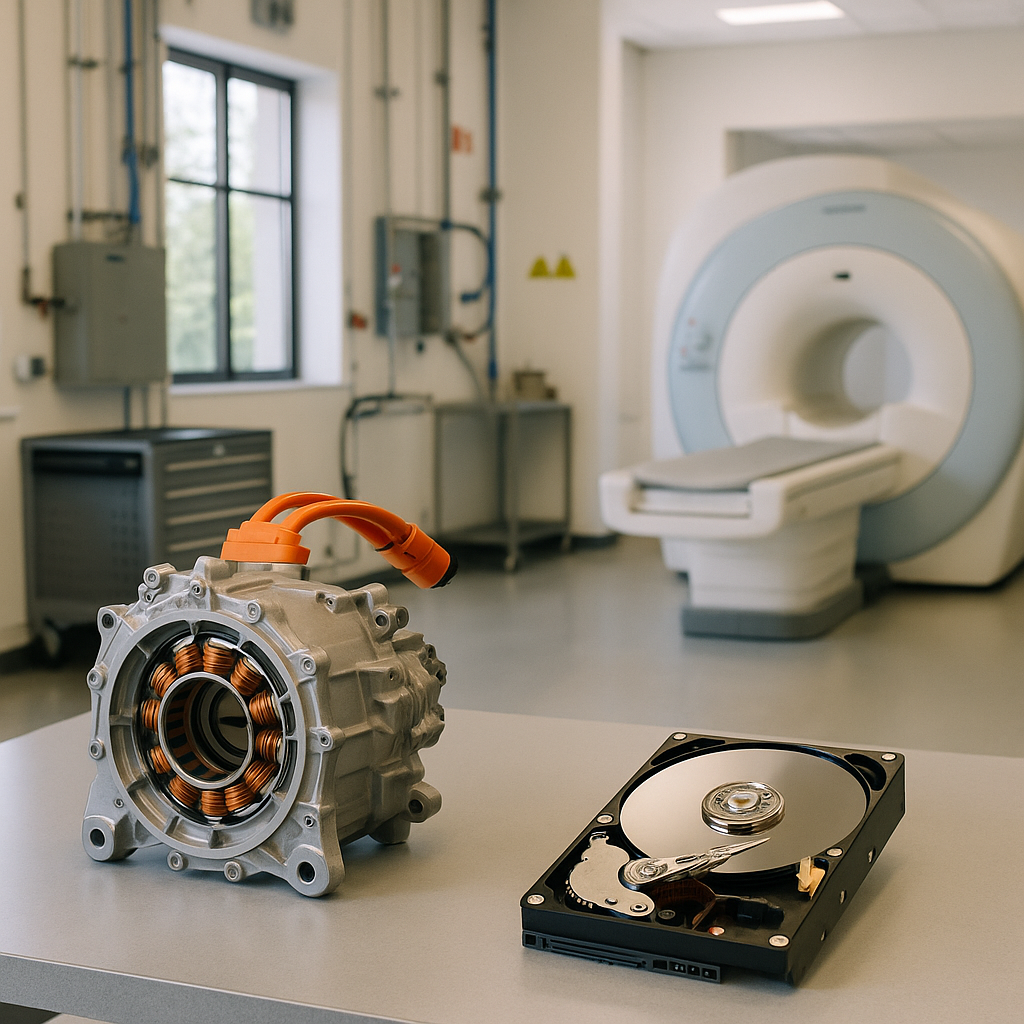5901 Botham Jean Blvd, Dallas, TX 75215
Is Cobalt Magnetic? Understanding Its Ferromagnetic Properties
June 4, 2025Cobalt is strongly magnetic. It belongs to a select group of materials known as ferromagnetic, which exhibit powerful magnetic properties that persist even after an external magnetic field is removed.
What gives cobalt this remarkable magnetic ability? The answer lies in its atomic structure. Cobalt atoms contain three unpaired electrons in their 3d orbital. These electrons act like tiny magnets. When exposed to a magnetic field, these unpaired electrons align in the same direction, creating a net magnetic moment.
This alignment isn’t temporary. Unlike paramagnetic materials that lose their magnetism when the external field disappears, cobalt retains its magnetic properties. This persistence makes cobalt valuable for applications requiring stable, long-lasting magnetic fields. The stability comes from cobalt’s hexagonal close-packed crystal structure, which helps maintain the magnetic alignment in specific directions.
What Makes Cobalt Unique Among Magnetic Materials?
Cobalt possesses exceptional magnetic qualities that set it apart from other ferromagnetic materials. Its remarkable Curie temperature of approximately 1,115°C (2,039°F) is one of its most defining features. At this temperature, cobalt transitions from ferromagnetic to paramagnetic, losing its ability to maintain magnetism without an external field. This temperature tolerance far exceeds that of other common magnetic materials.
Cobalt’s high magnetic permeability allows it to become magnetized with ease. When exposed to a magnetic field, cobalt’s unpaired electrons align quickly and efficiently. This property makes cobalt valuable in applications requiring rapid response to magnetic stimuli. Unlike materials with lower permeability, cobalt can achieve strong magnetization with less energy input.
Another standout characteristic is cobalt’s high coercivity, referring to its resistance to demagnetization once magnetized. Cobalt maintains its magnetic properties even when exposed to opposing magnetic fields or mechanical stress. This stability ensures that cobalt-based magnets remain reliable over extended periods in challenging environments.
Compared to iron and nickel, the other naturally occurring ferromagnetic elements, cobalt offers superior performance in high-temperature applications. Iron, while abundant and easily magnetized, loses its magnetic properties at much lower temperatures. Nickel, with its Curie point of approximately 354°C, cannot match cobalt’s thermal stability. This resistance to high temperatures makes cobalt indispensable in aerospace, automotive, and industrial environments where heat exposure is constant.
The unique atomic structure of cobalt contributes to its magnetic excellence. With three unpaired electrons in its 3d orbital, cobalt’s atoms create strong magnetic moments that align when exposed to a magnetic field. This alignment, stabilized by the exchange interaction between electrons, produces a cohesive and powerful magnetic field throughout the material.
Cobalt’s hexagonal close-packed crystal structure further enhances its magnetic anisotropy. This directional dependence of magnetic properties ensures cobalt maintains magnetic alignment along specific directions, contributing to its overall stability and reliability in magnetic applications.
These exceptional characteristics make cobalt an ideal material for permanent magnets used in electric motors, generators, and electronic devices. Cobalt-based magnets, particularly those alloyed with samarium or in combinations like Alnico (aluminum-nickel-cobalt), provide strong, stable magnetic fields crucial for precision equipment. In data storage technology, cobalt’s reliable magnetic properties ensure consistent performance in hard disk drives and other magnetic recording media.
The medical field also benefits from cobalt’s magnetic stability. MRI machines and various medical imaging technologies rely on the consistent magnetic properties that cobalt provides. Its biocompatibility allows for use in medical implants where magnetic properties are beneficial.
While cobalt offers these remarkable advantages, engineers must balance its benefits against factors like cost and availability when designing magnetic systems. Still, for applications requiring magnetic stability at high temperatures, few materials can match cobalt’s performance profile.
How Does Cobalt’s Atomic Structure Contribute to Its Magnetism?

Cobalt’s unique atomic structure is central to its magnetic properties. It has three unpaired electrons in its 3d orbital, which behave like tiny magnets aligning their spins in a magnetic field. This alignment creates a strong collective magnetic effect that remains even without the external field.
The unpaired electrons in cobalt’s d orbital are crucial for its magnetism. While electrons in most elements pair with opposite spins, cobalt’s electron configuration leaves three electrons unpaired. This setup creates a net magnetic moment, turning each cobalt atom into a mini magnet.
Cobalt naturally forms two crystal structures that enhance its magnetism. The hexagonal close-packed (HCP) structure is the most common at room temperature, creating strong magnetic anisotropy, meaning cobalt’s magnetism favors a specific direction. At higher temperatures, cobalt can adopt a face-centered cubic (FCC) structure.
The alignment of electron spins in cobalt happens through exchange interaction, a quantum mechanical effect causing neighboring unpaired electrons to align parallel. This powerful interaction creates strong internal magnetic fields, millions of times stronger than Earth’s magnetic field.
In solids, cobalt atoms form magnetic domains, microscopic regions where atomic magnets align in the same direction. Each domain acts as a unified magnet, with billions of aligned atoms. In unmagnetized cobalt, these domains point randomly, canceling each other out.
When exposed to an external magnetic field, cobalt’s domains reorganize dramatically. Domains aligned with the field grow, while opposing ones shrink, until all align with the field, creating a strong permanent magnet. Cobalt retains this alignment even after the field disappears, making it valuable for permanent magnets.
Cobalt’s high resistance to demagnetization, or magnetic coercivity, further enhances its magnetic properties. This resistance arises from the energy needed to rotate its magnetic moments due to its crystal structure, making cobalt-based magnets durable in challenging environments.
Temperature significantly affects cobalt’s magnetic behavior. Unlike many ferromagnetic materials, cobalt maintains its magnetism at extremely high temperatures. Its Curie temperature, the point where magnetism vanishes, is an impressive 1,115°C, making cobalt ideal for high-temperature applications where others fail.
What Are the Key Applications of Cobalt’s Magnetic Properties?

Cobalt’s exceptional magnetic properties make it indispensable across numerous industries. Its high Curie temperature of approximately 1,115°C allows it to maintain magnetic properties at temperatures where other materials fail. This stability positions cobalt as a critical material in modern engineering applications.
Permanent Magnets in Electric Motors and Generators
Cobalt is a key component in high-performance permanent magnets essential for electric motors powering vehicles and industrial machinery. The stability of cobalt-based magnets ensures reliable performance under heavy loads and high temperatures.
In electric generators, cobalt magnets efficiently convert mechanical energy into electrical energy. Their resistance to demagnetization makes them valuable in renewable energy applications like wind turbines, where reliability under continuous operation is crucial.
The automotive industry uses cobalt-based magnets for their excellent performance, enhancing electric vehicles with better power density and efficiency, leading to extended driving ranges and improved performance.
High-Performance Cobalt Alloys
Alnico, an alloy of aluminum, nickel, and cobalt, is noted for its magnetic strength and thermal stability, making it ideal for sensors, electric motors, and electronic devices operating across wide temperature ranges.
Samarium-cobalt (SmCo) rare earth magnets offer excellent stability and resistance to demagnetization, perfect for precision applications in aerospace, defense systems, and medical devices where reliability is crucial.
Cobalt-chrome alloys, combining magnetic properties with biocompatibility, are used in orthopedic implants and dental prosthetics, ensuring long-term performance inside the body.
Data Storage and Electronic Applications
The electronics industry relies on cobalt’s magnetic properties. Hard disk drives use cobalt films to store data magnetically, with high coercivity ensuring secure, long-term information storage.
Cobalt is vital in magnetic recording devices due to its stability and precision, essential for data storage technologies requiring reliable performance in demanding environments.
Smartphones and other electronics use cobalt-based magnets in speakers, microphones, and vibration motors, contributing to the functionality expected from modern devices.
Medical Technology Applications
Cobalt-based technologies have revolutionized medical imaging. MRI machines use powerful cobalt-alloy magnets to generate detailed images of internal structures, enabling non-invasive diagnostics.
Cobalt-60, a radioactive isotope, is crucial in radiation therapy for cancer treatment, offering precise tumor targeting while minimizing damage to healthy tissue.
In medical implants, cobalt-chrome alloys provide structural support and biocompatibility. Joint replacements, dental implants, and stents use these alloys for durability, corrosion resistance, and compatibility with imaging technologies.
Cobalt’s magnetic stability, strength, and versatility make it irreplaceable in modern technology, enabling advances across transportation, energy production, healthcare, and personal electronics.
Conclusion: The Magnetic Future of Cobalt

Cobalt’s exceptional magnetic properties make it indispensable in our technological landscape. Its high magnetic anisotropy, impressive thermal stability, and resistance to demagnetization are ideal for applications needing reliable performance under demanding conditions. From samarium-cobalt magnets in electric vehicles to cobalt-based recording media enabling high-density data storage, this versatile metal powers our increasingly connected world.
As research advances, we can expect new cobalt-based magnetic materials with enhanced properties to emerge. These innovations will likely support cutting-edge applications in quantum computing, aerospace technology, and renewable energy solutions. For businesses and municipalities seeking sustainable recycling solutions for cobalt-containing products, contact Okon Recycling at 214-717-4083.
